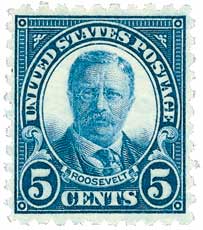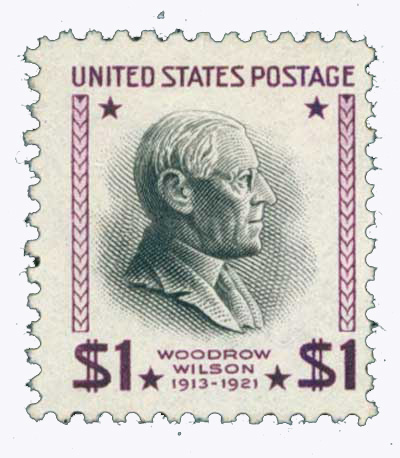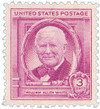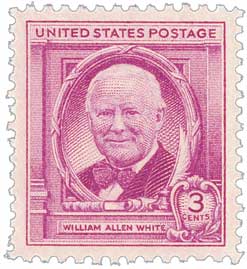
# 960 - 1948 3c William Allen White
3¢ William A. White
City: Emporia, KS
Quantity: 77,649,600
Printed by: Bureau of Engraving and Printing
Printing Method: Rotary Press
Perforations: 10 1/2 x 11
Color: Bright red violet
Birth Of William Allen White
He spent much of his childhood in El Dorado, Kansas, where he enjoyed reading and spending time with animals.
White went on to attend the College of Emporia and the University of Kansas before taking a job as an editorial writer with the Kansas City Star in 1892.

Three years later, White bought the Emporia Gazette for $3,000 and made himself the editor. In that role he shared his progressive ideals that would make him famous. Most notably, in 1896, White wrote an attack piece on William Jennings Bryan as well as Democrats and Populists that he called, “What’s the Matter With Kansas?”
In his piece, White criticized Populist leaders for allowing Kansas’ economy to struggle, while they helped neighboring states. He also called Bryan a socialist and claimed that “The election will sustain Americanism or it will plant socialism.” The Republican Party supported White’s writing and sent out hundreds of thousands of copies of it to support William McKinley’s presidential bid in 1896.

White soon became one of the leaders of the Progressive Movement in Kansas, creating the Kansas Republican League in 1912 to fight the railroads. That same year, he and Theodore Roosevelt broke off from the Republican Party and established their own Progressive Party. Named Bull Moose because Roosevelt said he was as fit as a bull moose to serve, they called for women’s suffrage, welfare assistance, farm relief, and changes to the banking and health insurance industries. They lost the 1912 election and dissolved entirely in 1916. Though their party failed, White and Roosevelt remained friends until Roosevelt’s death in 1919.

White went on to serve as a reporter at the Versailles Conference in 1919 and a vocal supporter of the League of Nations as suggested by Woodrow Wilson. As a writer, White was popular around the nation for his humorous, honest, and commonsense writing. Many of his articles were reprinted and distributed around the country and syndicated in other newspapers. He also wrote books, including biographies on Woodrow Wilson and Calvin Coolidge. Among his famous works was a touching tribute to his daughter, Mary. In 1923, White earned a Pulitzer Prize for his editorial “To an Anxious Friend” about his arrest following a free speech dispute over the treatment of men in the Great Railroad Strike of 1922.
White was often recognized as an unofficial spokesman for Middle America. Because of this, President Franklin Roosevelt enlisted him to help raise public support for the Allies before America joined in World War II. White helped to establish the Committee to Defend America by Aiding the Allies, which was also sometimes known as the WhiteCommittee. In this role he often faced off against the America First Group, which opposed America’s involvement in the war.
3¢ William A. White
City: Emporia, KS
Quantity: 77,649,600
Printed by: Bureau of Engraving and Printing
Printing Method: Rotary Press
Perforations: 10 1/2 x 11
Color: Bright red violet
Birth Of William Allen White
He spent much of his childhood in El Dorado, Kansas, where he enjoyed reading and spending time with animals.
White went on to attend the College of Emporia and the University of Kansas before taking a job as an editorial writer with the Kansas City Star in 1892.

Three years later, White bought the Emporia Gazette for $3,000 and made himself the editor. In that role he shared his progressive ideals that would make him famous. Most notably, in 1896, White wrote an attack piece on William Jennings Bryan as well as Democrats and Populists that he called, “What’s the Matter With Kansas?”
In his piece, White criticized Populist leaders for allowing Kansas’ economy to struggle, while they helped neighboring states. He also called Bryan a socialist and claimed that “The election will sustain Americanism or it will plant socialism.” The Republican Party supported White’s writing and sent out hundreds of thousands of copies of it to support William McKinley’s presidential bid in 1896.

White soon became one of the leaders of the Progressive Movement in Kansas, creating the Kansas Republican League in 1912 to fight the railroads. That same year, he and Theodore Roosevelt broke off from the Republican Party and established their own Progressive Party. Named Bull Moose because Roosevelt said he was as fit as a bull moose to serve, they called for women’s suffrage, welfare assistance, farm relief, and changes to the banking and health insurance industries. They lost the 1912 election and dissolved entirely in 1916. Though their party failed, White and Roosevelt remained friends until Roosevelt’s death in 1919.

White went on to serve as a reporter at the Versailles Conference in 1919 and a vocal supporter of the League of Nations as suggested by Woodrow Wilson. As a writer, White was popular around the nation for his humorous, honest, and commonsense writing. Many of his articles were reprinted and distributed around the country and syndicated in other newspapers. He also wrote books, including biographies on Woodrow Wilson and Calvin Coolidge. Among his famous works was a touching tribute to his daughter, Mary. In 1923, White earned a Pulitzer Prize for his editorial “To an Anxious Friend” about his arrest following a free speech dispute over the treatment of men in the Great Railroad Strike of 1922.
White was often recognized as an unofficial spokesman for Middle America. Because of this, President Franklin Roosevelt enlisted him to help raise public support for the Allies before America joined in World War II. White helped to establish the Committee to Defend America by Aiding the Allies, which was also sometimes known as the WhiteCommittee. In this role he often faced off against the America First Group, which opposed America’s involvement in the war.










